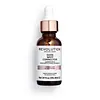What's inside
What's inside
 Key Ingredients
Key Ingredients

 Benefits
Benefits

 Concerns
Concerns

 Ingredients Side-by-side
Ingredients Side-by-side

Water
Skin ConditioningAscorbic Acid
AntioxidantDimethicone
EmollientGlycerin
HumectantAlcohol Denat.
AntimicrobialPotassium Hydroxide
BufferingPolysilicone-11
Pentaerythrityl Tetraethylhexanoate
EmollientAcetyl Dipeptide-1 Cetyl Ester
Skin ConditioningAdenosine
Skin ConditioningSodium Hyaluronate
HumectantTocopherol
AntioxidantSilica
AbrasiveAmmonium Polyacryloyldimethyl Taurate
Emulsion StabilisingButylene Glycol
HumectantCaprylyl Glycol
EmollientC13-14 Isoparaffin
EmollientHydroxyethylcellulose
Emulsion StabilisingLaureth-7
EmulsifyingPEG-20 Methyl Glucose Sesquistearate
EmulsifyingPoloxamer 338
EmulsifyingPolyacrylamide
Sorbitan Laurate
EmulsifyingXanthan Gum
EmulsifyingBis-PEG/PPG-16/16 PEG/PPG-16/16 Dimethicone
EmollientCaprylic/Capric Triglyceride
MaskingPentaerythrityl Tetra-Di-T-Butyl Hydroxyhydrocinnamate
AntioxidantSalicylic Acid
MaskingParfum
MaskingWater, Ascorbic Acid, Dimethicone, Glycerin, Alcohol Denat., Potassium Hydroxide, Polysilicone-11, Pentaerythrityl Tetraethylhexanoate, Acetyl Dipeptide-1 Cetyl Ester, Adenosine, Sodium Hyaluronate, Tocopherol, Silica, Ammonium Polyacryloyldimethyl Taurate, Butylene Glycol, Caprylyl Glycol, C13-14 Isoparaffin, Hydroxyethylcellulose, Laureth-7, PEG-20 Methyl Glucose Sesquistearate, Poloxamer 338, Polyacrylamide, Sorbitan Laurate, Xanthan Gum, Bis-PEG/PPG-16/16 PEG/PPG-16/16 Dimethicone, Caprylic/Capric Triglyceride, Pentaerythrityl Tetra-Di-T-Butyl Hydroxyhydrocinnamate, Salicylic Acid, Parfum
Water
Skin ConditioningGlycerin
HumectantPropanediol
SolventSodium Ascorbyl Phosphate
AntioxidantNiacinamide
SmoothingMannitol
HumectantSalicylic Acid
MaskingPhenoxyethanol
PreservativeSodium Gluconate
Skin ConditioningHydroxyethylcellulose
Emulsion StabilisingEthylhexylglycerin
Skin ConditioningDisodium EDTA
Citric Acid
BufferingSodium Citrate
BufferingWaltheria Indica Leaf Extract
Skin ConditioningDextrin
AbsorbentFerulic Acid
Antimicrobial
 Reviews
Reviews

Ingredients Explained
These ingredients are found in both products.
Ingredients higher up in an ingredient list are typically present in a larger amount.
Glycerin is already naturally found in your skin. It helps moisturize and protect your skin.
A study from 2016 found glycerin to be more effective as a humectant than AHAs and hyaluronic acid.
As a humectant, it helps the skin stay hydrated by pulling moisture to your skin. The low molecular weight of glycerin allows it to pull moisture into the deeper layers of your skin.
Hydrated skin improves your skin barrier; Your skin barrier helps protect against irritants and bacteria.
Glycerin has also been found to have antimicrobial and antiviral properties. Due to these properties, glycerin is often used in wound and burn treatments.
In cosmetics, glycerin is usually derived from plants such as soybean or palm. However, it can also be sourced from animals, such as tallow or animal fat.
This ingredient is organic, colorless, odorless, and non-toxic.
Glycerin is the name for this ingredient in American English. British English uses Glycerol/Glycerine.
Learn more about GlycerinHydroxyethylcellulose is used to improve the texture of products. It is created from a chemical reaction involving ethylene oxide and alkali-cellulose. Cellulose is a sugar found in plant cell walls and help give plants structure.
This ingredient helps stabilize products by preventing ingredients from separating. It can also help thicken the texture of a product.
This ingredient can also be found in pill medicines to help our bodies digest other ingredients.
Learn more about HydroxyethylcelluloseSalicylic Acid (also known as beta hydroxy acid or BHA) is a well-known ingredient for treating skin that struggles with acne and clogged pores. It exfoliates both the skin's surface and deep within the pores to help clear out buildup, control oil, and reduce inflammation.
Unlike AHAs (alpha hydroxy acids), salicylic acid is oil-soluble. This allows it to penetrate into pores which makes it especially effective for treating blackheads and preventing future breakouts.
Salicylic acid is also known for its soothing properties. It has a similar structure to aspirin and can calm inflamed or irritated skin, making it a good option for acne-prone skin that is also sensitive.
Concentrations of 0.5-2% are recognized by the U.S. FDA as an over-the-counter topical acne product.
It can cause irritation and/or dryness if one's skin already has a compromised moisture barrier, so it's best to focus on repairing that before introducing this ingredient into your routine.
While salicylic acid does not increase sun sensitivity, it’s still important to wear sunscreen daily to protect your skin.
If you are looking for the ingredient called BHA or Butylated Hydroxyanisole, click here.
Learn more about Salicylic AcidWater. It's the most common cosmetic ingredient of all. You'll usually see it at the top of ingredient lists, meaning that it makes up the largest part of the product.
So why is it so popular? Water most often acts as a solvent - this means that it helps dissolve other ingredients into the formulation.
You'll also recognize water as that liquid we all need to stay alive. If you see this, drink a glass of water. Stay hydrated!
Learn more about Water